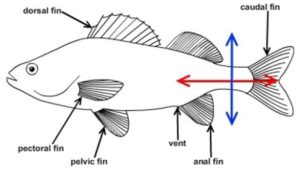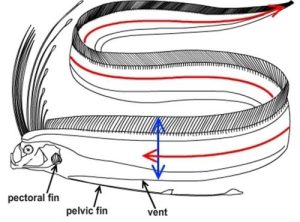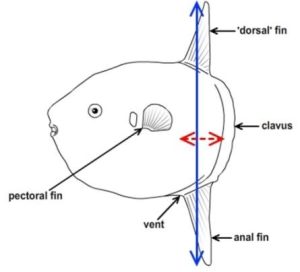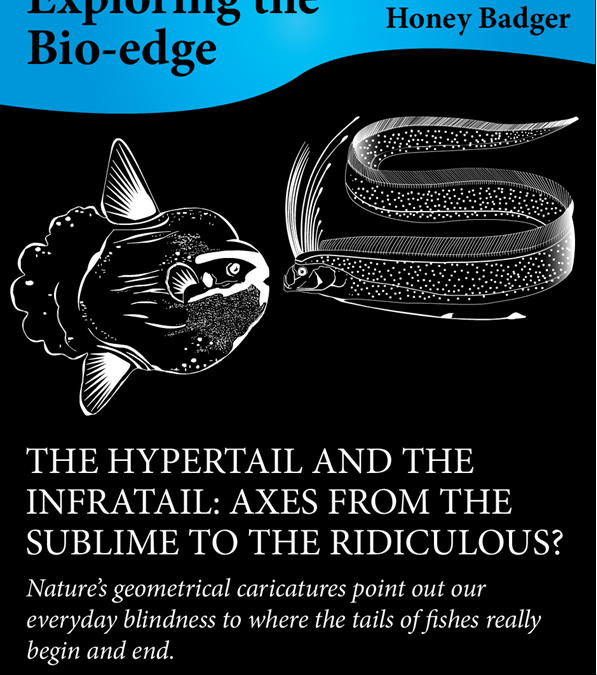Note to readers: Biological Expositions is a series of blog-posts each of which is equivalent in content to a book chapter. If bio-bullets are likened to a starter, blog-posts could be seen as a light lunch and Biological Expositions as a three course meal. We look forward to your comments on this series.
Nature’s geometrical caricatures point out our everyday blindness to where the tails of fishes really begin and end.
The oarfish and the ocean sunfish are unusual fishes of the deep sea. Both are widespread in the tropical to temperate oceans, although rarely seen. Both have small mouths and eat jellyfish, suspended crustaceans, and other relatively small organisms. And both are extreme in their own ways, making for a potentially revealing comparison between the longest tail and the shortest tail among fishes.
The oarfish has a tail that can be longer than a difficult-to-believe 10 metres. By contrast, the ocean sunfish, despite weighing more than a female hippo, lacks a conventional tail and even has a much-reduced spinal column within the body. So here we have similar lifestyles despite the greatest conceivable difference in the development of the axial skeleton of vertebrates. As we contemplated this structural divergence but functional convergence, our eyes were opened to the true nature of tails in even the most normal of fishes.
First let us put some more flesh on our sketches of two species of fishes that are extreme in opposite ways. The oarfish is the longest of all the tens of thousands of species of ‘bony fishes’, mature specimens reaching approximately 15 metres. By contrast, the ocean sunfish is exceptionally short for its mass, and has a cartilaginous instead of bony skeleton, but is the heaviest of all ‘bony fishes’ at up to 2.3 tonnes. Both have small pectoral fins and lack a conventional caudal fin. The pelvic fins are streamer-like in the oarfish and absent in the ocean sunfish, neither appearing functional for locomotion. Both these fishes lack a swim bladder, are scaleless but have armoured skin, and have jelly-like flesh. Despite the semblance of the ocean sunfish to a disembodied head, its brain appears to be no bigger than that of the oarfish, both species being among the least brainy of fishes relative to body mass.
Both the oarfish and the ocean sunfish reproduce by laying many small eggs in the open sea. In the case of the ocean sunfish the number laid (300 million or more at a time) exceeds that of any other vertebrate, as does the difference in size between hatchling and adult. In both cases, the larvae look quite different from the adults with body proportions not drastically different from those of other fishes. However, as their bodies grow towards maturity, the directions in which this growth occurs are so different that it is difficult to reconcile these as functionally similar fishes in the same oceans.
Human appreciation of where the tail of fishes begins and ends tends to be poor, even in ‘normal’ fishes such as goldfish, trout, or perch. This is possibly because, as a tailless species, our minds are ill-primed. Consequently, before we delve into the differences between oarfish and ocean sunfish, our next paragraph presents a frame of reference by sketching the ins and outs of the normal tail of bony fishes.
Bony fishes differ from most other vertebrates in the sheer size of the tail relative to the rest of the body, and in the elaboration of the tail into not one but several separate fins and fin lobes. Because textbooks seldom present this material clearly, it is easy to underlook the fact that the muscle we eat in the form of fish fillets is, more often than not, that of the tail, not the body. This is highlighted by the fact that in many bony fishes the tail, including all its various fins, has a total surface area exceeding that of the head and body (including dorsal, pectoral, and pelvic fins). A first step in appreciating the true ‘tailiness’ of fishes is to find the posterior orifice, where the tail logically begins. This vent, the orifice of the cloaca, tends to be located centrally on the ventral surface of commercial fishes rather than on their hindquarters (see inserted figures of various fishes and their anatomy).

Figure 1. The tail has standard geometry in this most ordinary of fishes, a perch [image © Robin and the Honey Badger].

Figure 2. The oarfish labelled for the comparison with the perch, showing a tail so long that it no longer beats like the tail of an ordinary fish [image © Robin and the Honey Badger].
Figure 3. The ocean sunfish labelled for comparison with perch and oarfish, showing a tail so short that its main movements are perpendicular to those of an ordinary fish [image © Robin and the Honey Badger].
Viewed against the template of normal fishes, the tails of both the oarfish and the ocean sunfish seem to have fallen off the edge of the drawing board. For example, neither species has retained the conventional caudal fin that is taken for granted in most fishes. In the oarfish, the fleshy part of its tail has been lengthened so much that its conventional caudal fin has been attenuated to oblivion, actually simplifying the tail in a sense. In the ocean sunfish, the conventional caudal fin has also been lost but, in sealing off the truncation, this species has produced a false, non-propulsive tail (called a clavus) out of the adjacent parts of its remaining, unconventional, tail fins.
If there could be said to be a ‘hypertail’ among fishes, the oarfish has it. The tapering tail of a 15 metre specimen would be at least 11 metres, making it the longest tail of any living animal. The next longest fish tail, that of the mature whale shark, is less than 7.5 metres long despite comprising more fins than that of the oarfish and belonging to an incomparably more massive fish. This supremacy of the oarfish in tail length must bring some sort of advantage, but it is not clear what exactly this might be. Based on our currently poor knowledge, this seems an excessive focus on one anatomical feature at the expense of more essential organs. For example, in the oarfish, a long pocket of the gut extends several metres past the vent into the tail, in contrast to normal fishes, which fit all of the internal organs into the main body cavity in front of the tail.
Apart from squeezing organs into unusual places, the oarfish has also had to develop apparently novel modes of locomotion, presumably owing to its unwieldy tail. Unlike normal fishes, swimming by the oarfish is not achieved by a sideways beating of the tail, but rather by a subtle rippling movement of the long ribbon-like ‘dorsal’ fin that runs from the head down to the tip of the tail. Because nervous control of the ‘posterior dorsal’ fin is presumably conveyed down the length of the tail by the spinal column, it seems likely that the spinal column runs virtually to the tip of the tail. This anatomical detail is relevant: despite the apparent vulnerability of this long spinal column, a high percentage of captured oarfish bear scars on, or have lost portions of, the tail. It seems therefore that an oarfish can survive the loss of considerable portions of its posterior half, including some of the spinal column, to predators. The only other fishes that show a similar adaptation are certain eel-like forms of the deep sea.
Moving from the sublime to the ridiculous (or possibly the other way around): if there could be said to be an ‘infratail’ among fishes, the ocean sunfish has it. In contrast to the long trailing ribbon shape of the oarfish, the body of the adult ocean sunfish has a disconcerting cut-off appearance. Its style of locomotion is as odd as that of the oarfish, being similar to a turtle or penguin swimming on its side but beating the symmetrically projecting, pointed sections of the dorsal and anal fins in place of flippers. These flipper-like fins are actually only parts of the original fins, the other sections having been distorted in the opposite direction to meet each other in the form of a fusion called the clavus (our picture will be worth many more words). Thus the fringe on the tail-end of the ocean sunfish is even less like the conventional caudal fin than it may appear. This is one of the few fishes lacking any caudal vertebrae.
Yet another oddity of the ocean sunfish is that, within the vertebral column of its trunk, the central nervous system itself projects less than 3 centimetres behind the brain. Please remember that the entire fish is up to 3.3 metres long when mature. Although the larva starts with a vertebral column of unremarkable proportions, most of the bones atrophy during their growth. The result of this loss is that the spinal column of the whole tail and much of the body vanishes, while sections of the two remaining fins of the tail are fused to form a weak substitute.
The ocean sunfish not only has an extremely short tail, but is also one of the few fishes in which the vertical axis of the tail is the major axis of the tail. Thus, if the tails of normal fishes represent a balance of dimensions on a crossing system of axes, the oarfish has favoured its horizontal axis well beyond most eels. Meanwhile, the ocean sunfish has virtually abandoned its horizontal axis and has reinvented the normal orientation of the fish body by adopting the vertical as its main axis. Both extremes appear absurd because, based on our current understanding, it seems that the oarfish has metres of redundant spinal column and associated flesh while the ocean sunfish is in debt of the same parts of its anatomy.
As if the perversity of all of this is not enough, the few observations of normal posture of the oarfish show it upright during its normal behaviour. This means that what we have illustrated as a horizontal tail is held vertically as the fish hovers or swims slowly by means of a counter-propagating wave on its ‘dorsal’ fin. Not only does the oarfish appear not to use its tail in the usual side-to-side movement of other fishes, but even its relationship to horizontal versus vertical is confused – raising the possibility that it is actually the oarfish that has the ‘infratail’.
It is difficult to imagine a more graphic example of fishes with like function but unlike form. In a sense, this, the longest of all living tails, is functionally redundant. The oarfish has metre after metre of apparently dispensable tail flesh, which appears – although this needs confirmation – to be incapable of beating like a normal fish tail but capable of healing after amputation in appeasement of a predator. By contrast, the ocean sunfish virtually amounts to a giant, sutured self-truncation, developing from larva to adult in such a way as to resorb its tail except for two fins that most of us would not recognise as belonging to the tail in the first place. It is as if Nature has made a game of taking lateral thinking in opposite directions, to two points just beyond the plausible. And so both the hypertail and the infratail may find themselves tailless in the same ocean: the ocean sunfish having resorbed its tail within a skin so tough that even a harpoon would not penetrate it, and the oarfish appending a tail so superfluous that – if hypothetically harpooned – most of it might be forfeited without the death of the fish.
And we are left gazing at the wedge of ordinary fish on our dinner plate with a new appreciation of its normality.
***
All text and images appearing in this blog are subject to copyright, except those images explicitly stated to be in the public domain. You are not free to use any photographs, for any purpose, without receiving written permission from the copyright holder.

